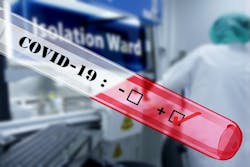As the first doses of a COVID-19 vaccine from Pfizer and BioNTech arrive at locations throughout the United States, healthcare workers are among the first to be inoculated, according to a suggested list of priorities recommended by the Centers for Disease Control and Prevention (CDC).
The rapid start to distributing the vaccine began after the U.S. Food and Drug Administration issued the first emergency use authorization (EUA) for a vaccine for the prevention of COVID-19 in individuals 16 years of age and older, allowing a vaccine from Pfizer-BioNTech to be distributed in the United States, according to a press release from the agency.
In July, the U.S. government announced plans to purchase 100 million doses of the 2-dose vaccine, or enough for 50 million people.
Daunting challenges, including the logistics involved in distributing the vaccine, remained.
For example, the vaccine needs to be stored at temperature conditions at around -70 degrees Celsius. That is why the companies have developed specially designed, temperature-controlled thermal shippers utilizing dry ice. Each shipper contains a GPS-enabled thermal sensor to track the location and temperature of each vaccine shipment across their pre-set routes. The Pfizer-BioNTech vaccine can also be stored in ultra-low-temperature freezers for up to six months
Public perception about the safety of COVID-19 vaccines also is an issue to be addressed. In a recent Gallup poll, 63 percent of Americans said they were willing to get inoculated, up from 50 percent in September 2020, which was the low point in the public’s vaccine readiness.
The FDA said the decision to grant EUA was based on a rigorous, albeit time-compressed, process. It noted that the data supported the conclusion that the “potential benefits outweigh the known and potential risks, supporting the vaccine’s use in millions of people 16 years of age and older, including healthy individuals. In making this determination, the FDA can assure the public and medical community that it has conducted a thorough evaluation of the available safety effectiveness and manufacturing quality information.”
The Pfizer-BioNTech COVID-19 vaccine contains messenger RNA (mRNA), which is genetic material. The vaccine contains a small piece of the SARS-CoV-2 virus’s mRNA that instructs cells in the body to make the virus’s distinctive “spike” protein. When a person receives this vaccine, their body produces copies of the spike protein, which does not cause disease, but triggers the immune system to learn to react defensively, producing an immune response against SARS-CoV-2.
Pfizer BioNTech COVID-19 vaccine is administered as a series of two doses, three weeks apart. The available safety data to support the EUA include 37,586 of the participants enrolled in an ongoing randomized, placebo-controlled international study, the majority of whom are U.S. participants. These participants, 18,801 of whom received the vaccine and 18,785 of whom received saline placebo, were followed for a median of two months after receiving the second dose.
The most commonly reported side effects, which typically lasted several days, were pain at the injection site, tiredness, headache, muscle pain, chills, joint pain, and fever. Of note, more people experienced these side effects after the second dose than after the first dose, so it is important for vaccination providers and recipients to expect that there may be some side effects after either dose, but even more so after the second dose.
It is mandatory for Pfizer-BioNTech Pfizer to report the following to the Vaccine Adverse Event Reporting System (VAERS) on its COVID-19 Vaccine: all vaccine administration errors, serious adverse events, cases of Multisystem Inflammatory Syndrome (MIS), and cases of COVID-19 that result in hospitalization or death.

